“Injection molds are made from different metals and alloys, including Aluminum. Aluminum is a favored material in mold manufacturing due to its various qualities. The versatile grades of aluminum provide the necessary hardness, thermal conductivity, machinability, and other essential properties for effective injection molds. “
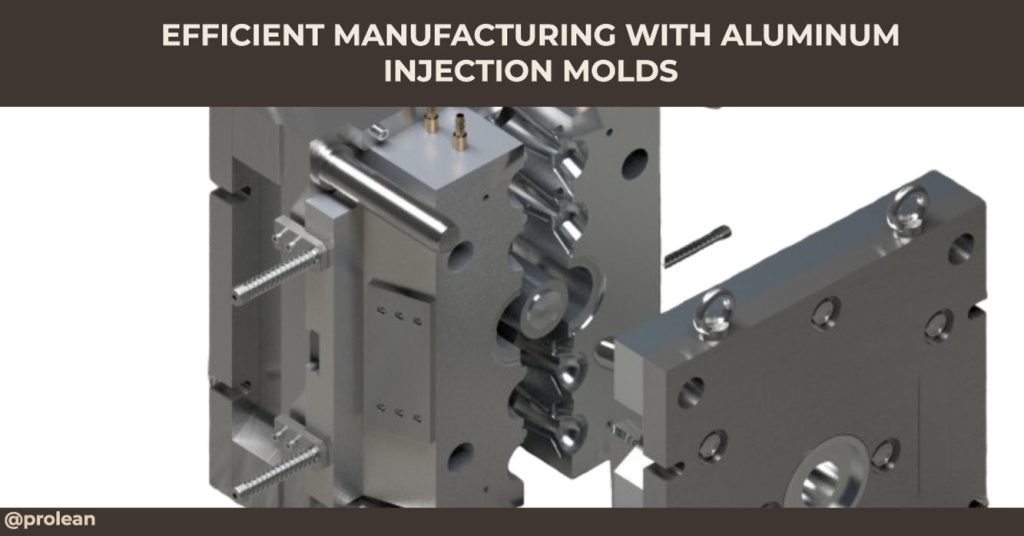
Aluminum injection molds are used in manufacturing for shaping a wide range of plastic products, from simple household items to complex automotive & aerospace components. One of the main reasons for using aluminum for injection molds is it heats and cools much faster than steel, which means that each production cycle is shorter, particularly suitable for rapid prototyping and small-batch manufacturing. The precise manufacturing of aluminum injection molds ensures every molded part or product meets the exact requirements, minimizing waste and improving overall quality. So, it is critical to understand the various elements of aluminum injection molds to optimize your injection molding project.
In this article, We will navigate various aspects of aluminum injection molds, including the mold-making process, cost implications, advantages, applications, and their significant role in efficient manufacturing practices.
What are the Materials for Injection Mold Making?
In injection mold making, the choice of material is critical. The selected material must balance durability, cost, and performance to meet the specific needs of the molding process. From aluminum to steel, there are different metals and alloys for mold creation. However, let’s understand what is an injection mold exactly.
What is an Injection Mold?
An injection mold is a tool used in manufacturing to shape metals and plastics, a mirror of the desired geometry in the form of cavities. It’s custom-designed into which molten plastic is injected and cooled to form the final product. The design and precision of the mold are crucial for the quality of the finished product.
These molds are designed to withstand high pressures and temperatures. The material’s ability to resist wear and tear while maintaining accuracy in shape and dimensions is vital for successful production runs.
Related: Injection Molding Gate: Expert Insights on Design & Manufacturing
Materials for Injection Mold Making
The choice of material for injection molds depends on various factors like the production volume, the plastic that will be processed, the desired finish, and more. Common materials include steel, aluminum, and beryllium-copper alloys.
Let’s see a detailed table comparing the properties of various materials used in injection mold creation.
Table: Injection Mold Making Materials
|
Material |
Durability |
Cooling Rate |
Cost |
Best Used For |
|
Steel |
High (excellent wear resistance) |
Slower than aluminum |
Higher (especially for hardened steels) |
High-volume production, complex designs |
|
Moderate (less wear resistance than steel) |
Fast (excellent thermal conductivity) |
Lower (cost-effective for prototyping) |
Prototyping, low-volume production |
|
|
Beryllium-Copper Alloy |
High (good wear resistance) |
Very Fast |
Higher (due to specialized properties) |
Areas requiring rapid heat removal, fine detailing |
|
High (excellent corrosion resistance) |
Moderate to Slow |
Higher (due to corrosion-resistant properties) |
Molds used in corrosive environments |
Try Prolean Now!
Why Aluminum for Injection Molds?
In injection mold-making, the material selection must possess specific properties to ensure efficient, high-quality production. The material should offer excellent thermal conductivity for rapid cooling, sufficient hardness to withstand the pressure, and corrosion resistance to ensure longevity.
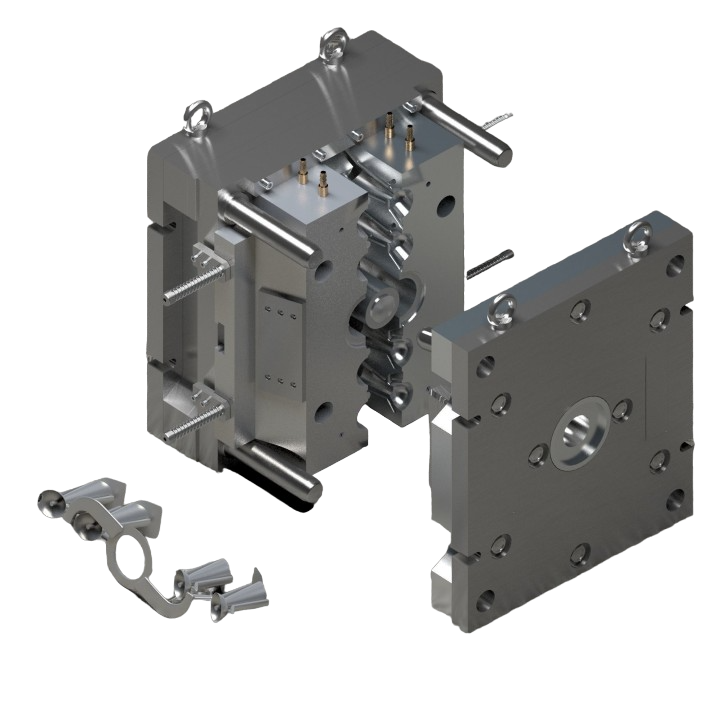
An injection mold made with Aluminum
Aluminum is increasingly becoming the material of choice for injection molds because it has all of the above properties. In fact, It has about twice the thermal conductivity per unit weight than that of copper ( 237 W m−1 K−1) and a 1.5 times more strength-to-weight ratio than stainless steel.
The following list highlights the reasons for its popularity.
- Superior Thermal Conductivity: Aluminum excels in thermal conductivity, allowing for faster cooling of the mold. This results in quicker cycle times, which means more parts can be produced in a shorter period.
- Lightweight Yet Strong: Despite being lighter than steel, aluminum is strong enough to handle the pressures and stresses involved in injection molding. This makes handling and maintenance easier and more efficient.
- Cost-Effectiveness: Aluminum molds are generally less expensive to manufacture than steel molds. This cost advantage makes them ideal for prototyping and low-volume production runs.
- Faster Machining: Aluminum can be machined faster than steel, which speeds up the mold-making process. This is particularly beneficial when tight deadlines are involved, as it allows for quicker turnaround times.
- Excellent Surface Finish: Aluminum molds can achieve high-quality surface finishes, better aesthetics, and functionality of the final product.
- Longevity in Low-Volume Production: In low to medium-production runs, aluminum molds exhibit excellent durability, making them a practical and economical choice.
- Reduced Lead Times: Due to its ease of machining and availability, aluminum molds can be produced with shorter lead times compared to other materials.
- Less Prone to Rusting: Unlike some steel varieties, aluminum is less prone to rusting, has less maintenance, and has a longer lifespan in some environments.
- Flexibility in Design Changes: Aluminum allows for easier modification of the mold design, which is particularly advantageous during the prototyping phase or when design adjustments are necessary.
Aluminum Alloys for Mold-Making
Aluminum alloys are a popular choice for mold-making due to their unique properties, Different grades of aluminum alloys go through CNC machining or EDM. Here’s a detailed table outlining various grades of aluminum alloys commonly used in mold-making, along with their properties and typical applications:
Table: Aluminum Alloys for Injection Molds
| Alloy Grade | Key Properties | Typical Applications | Advantages |
| 6061 | Good mechanical properties, excellent corrosion resistance | General-purpose molds, automotive parts, consumer goods | Versatile, easy to machine, weldable |
| 7075 | Very high strength, good fatigue resistance | Aerospace components, high-stress applications | Superior strength-to-weight ratio, high durability |
| 5083 | High strength, exceptional thermal conductivity | Heavy-duty molds, high-performance components | Resistant to thermal stress, ideal for high-temperature applications |
| 2024 | High strength, good fatigue resistance | Precision components, aerospace applications | High mechanical properties, suitable for tightly toleranced molds |
Related: Unraveling the Differences: 6061 Aluminum vs. Other Alloys in Aluminum CNC Machining
The Process of Creating Aluminum Injection Molds
Aluminum injection mold creation is a precise and intricate process, blending art and engineering to produce molds that meet specific manufacturing requirements. It involves several stages, each critical to the overall quality and functionality of the mold
1. Designing the Mold
The process begins with designing the mold. This stage requires a thorough understanding of the final product’s specifications and the molding material’s properties. Engineers create a detailed 3D model of the mold Using advanced design software. This model includes all the features of the final product, such as cavities, cores, runners, and gates. The design must also account for the shrinkage of the plastic during cooling and the ease of ejection of the finished part.
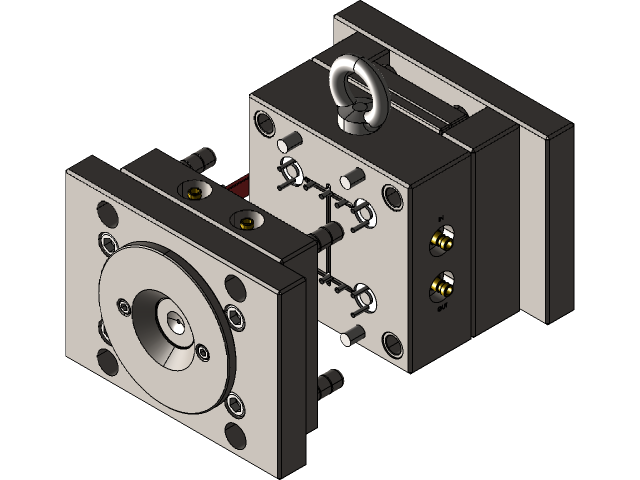
CAD of an Aluminum injection mold
2. Choosing the Right Aluminum Alloy
Once the design is finalized, the next step is selecting the appropriate aluminum alloy. This choice depends on factors like the expected production volume, the plastic material to be used, and the required thermal conductivity. Alloys like 6061 and 7075 are common due to their balance of strength, machinability, and thermal properties.
3. Machining of the Mold
With the design and material ready, the actual manufacturing of the mold begins. This is primarily done through CNC machining or EDM machining. Tolerances in CNC or EDM machines are high and they can precisely cut the aluminum block according to the mold’s design. However, “this process requires skilled operators and programmers to ensure that the dimensions and tolerances are accurately followed.”
4. Finishing and Polishing
After machining, the mold undergoes finishing and polishing. This step is crucial as it impacts the surface finish of the final product. Any imperfections on the mold surface can translate to the plastic part. Therefore, a high level of smoothness and precision is maintained during this phase. Otherwise, a weak surface finish affects the flow and reduces the quality of molded parts.
5. Mold Assembly
Assembling the mold includes installing components like ejector pins, sliders, and cooling systems. The assembly must be precise, as any misalignment can affect the mold’s functionality and the quality of the final product.
6. Testing and Troubleshooting
Before the mold goes to production, it undergoes rigorous testing. The testing involves running several trials to check for defects in the final product and ensuring that the mold meets all specifications. If issues are found, adjustments are made. This step is crucial to avoid costly errors during mass production.
7. Final Adjustments and Quality Control
After testing, final adjustments are made to refine the mold. Quality control measures are implemented to ensure that the mold is ready for production. The QC includes checking for dimensional accuracy, surface finish, and overall functionality.
Click here to download: Creating an Aluminum Injection Mold
Try Prolean Now!
Aluminum Injection Mold Manufacturing: CNC, EDM, and Their Combination
Aluminum injection mold manufacturing utilizes advanced techniques like CNC (Computer Numerical Control) machining and EDM (Electrical Discharge Machining). Each method offers unique advantages and is key to creating precise and high-quality molds.
1. CNC Machining of Aluminum Injection Mold
CNC machining involves the use of computer-controlled tools to shape the aluminum into a mold. This precise process allows for the creation of complex geometries and fine details in the mold. CNC machining is preferred for its speed and accuracy, making it ideal for producing molds with tight tolerances and intricate designs.
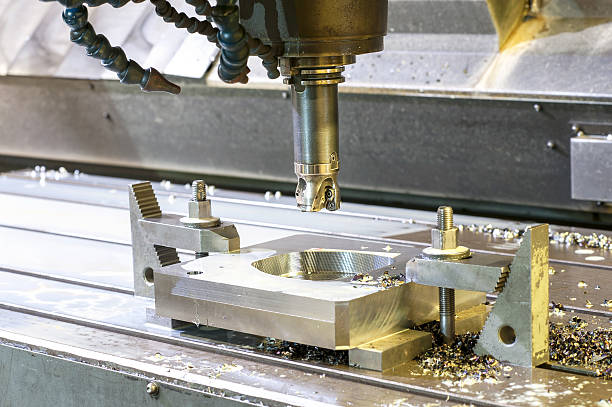
CNC machining for Aluminum injection mold
The advantages of CNC in aluminum injection mold manufacturing include its efficiency and repeatability. The process is automated, which minimizes human error and ensures consistent quality across multiple molds. CNC machining also allows for flexible design changes, making it suitable for both prototyping and production.
2. EDM Machining of Aluminum Injection Mold
EDM machining is another crucial technique in mold manufacturing. It involves using electrical discharges to mold aluminum. This method is particularly useful for creating intricate details or internal features that are challenging to achieve with traditional machining.
https://proleantech.com/electrical-discharge-machining/
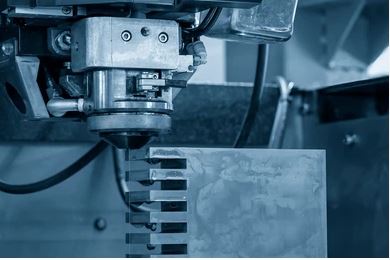
EDM for Aluminum mold-making
EDM machining is known for its precision and ability to machine complex shapes and fine details. It’s especially beneficial for producing sharp corners, deep cavities, or thin walls in molds. This method doesn’t exert physical force on the aluminum, reducing the risk of distortion or damage to the mold.
Table: CNC Vs. EDM Aluminum injection Mold-making
| Aspect | CNC Machining | EDM Machining |
| Precision | High precision, suitable for complex shapes and details | Exceptionally precise, ideal for intricate features and fine details |
| Speed | Faster process, ideal for quick production cycles | Slower than CNC, but offers unmatched detail precision |
| Complexity | Suitable for a wide range of complex designs | Excels in creating extremely intricate and challenging geometries |
| Surface Finish | Excellent surface finish, reducing the need for post-processing | Produces a very smooth finish, especially in hard-to-reach areas |
| Cost | Generally more cost-effective for larger volumes | Higher cost due to slower processing time, but invaluable for specific applications |
Related: EDM vs CNC Milling: Unveiling Key Differences in a Comprehensive Comparative Study
3. The combination of CNC and EDM
Combining CNC and EDM machining leverages the strengths of both processes to produce superior aluminum injection molds. This hybrid approach allows for the intricate detailing of EDM and the speed and efficiency of CNC. It’s especially beneficial for molds requiring complex geometries and fine surface finishes.
The advantage of this combination is the ability to utilize the precision of EDM for intricate parts of the mold and the rapid material removal capabilities of CNC for larger, less complex areas. This results in a more efficient production process, ensuring high-quality molds with reduced manufacturing time and costs.
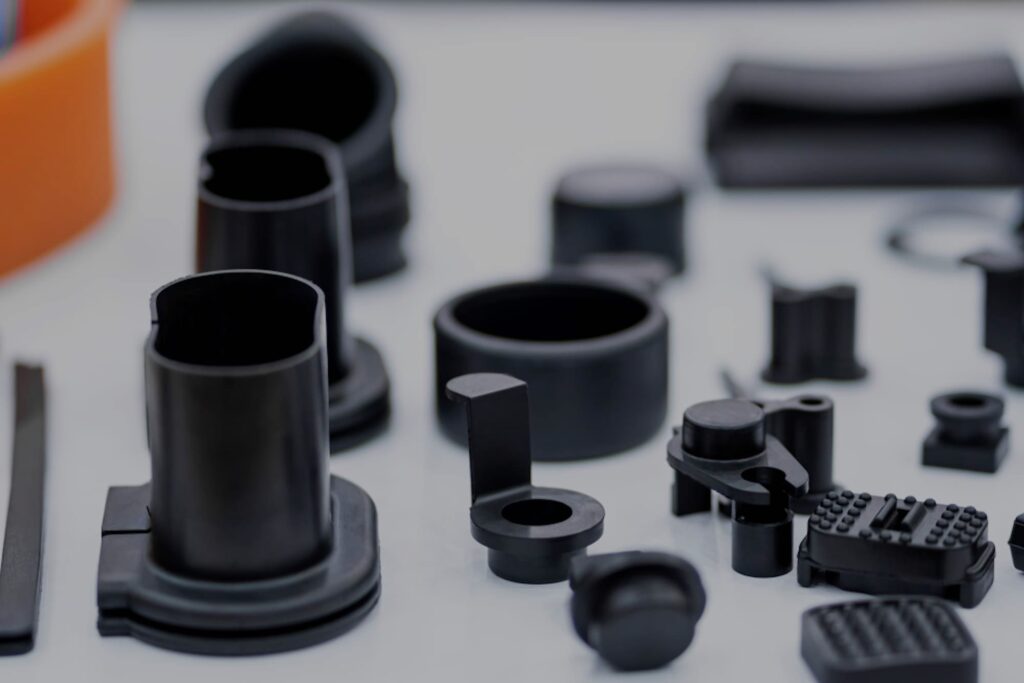
Injection molded plastic part
The ability to efficiently mold different plastics highlights the adaptability of aluminum molds for plastic injection molding. Aluminum injection molds are crucial in manufacturing, especially in shaping various types of plastics in prototyping and short-run productions. Here’s a look at some plastics commonly used and corresponding aluminum injection mold applications.
ABS (Acrylonitrile Butadiene Styrene)
- Automotive components like dashboards and panels.
- Consumer electronics such as TV frames and computer keyboards.
- Toys including Lego bricks and action figures.
- Home appliances like vacuum cleaners and blenders.
- Medical devices such as nebulizers and inhalers.
Polycarbonate (PC)
- Eyewear lenses and safety goggles.
- Bulletproof glass and security components.
- Electronic components like smartphone bodies.
- Medical devices and laboratory equipment.
- Automotive components like headlight lenses.
Polypropylene (PP)
- Automotive interiors and bumpers.
- Packaging materials, including food containers.
- Medical syringes and laboratory equipment.
- Consumer goods like water bottles and storage containers.
- Textile industry for ropes, carpets, and thermal underwear.
Polyethylene (PE)
- Packaging films and plastic bags.
- Containers like bottles and caps.
- Toys and playground equipment.
- Automotive fuel tanks and interior panels.
- Piping systems for water and gas distribution.
Nylon (Polyamide)
- Automotive components like gears and bearings.
- Electronic insulators and connectors.
- Industrial machinery components.
- Sports equipment like ski bindings and fishing lines.
- Textiles and high-strength ropes.
Polyethylene Terephthalate (PET):
- Beverage bottles and food packaging containers.
- Cosmetic containers and toiletry bottles.
- Pharmaceutical packaging including pill bottles.
- Clothing fibers and textile applications.
- Automotive parts like wiper arm covers and headlamp retainers.
Acrylic (PMMA – Polymethyl Methacrylate):
- Transparent applications like aquariums and display cases.
- Automotive lights and reflectors.
- Signage and light fixtures.
- Medical devices like incubators and dental applications.
- Eyewear lenses and optical devices.
Polystyrene (PS):
- Disposable cutlery, plates, and other tableware.
- Packaging materials, including foam peanuts and rigid foams.
- CD and DVD cases.
- Medical test tubes and petri dishes.
- Insulation materials for construction.
Aluminum Injection Molds for Rapid Prototyping of Plastic Parts
Aluminum injection molds are indispensable in rapid prototyping, offering unmatched speed and efficiency. Their excellent thermal conductivity allows for quick cooling and faster production cycles, making them ideal for creating detailed prototypes swiftly. This rapid turnaround is crucial in product development, especially since it can reduce the time-to-market significantly.
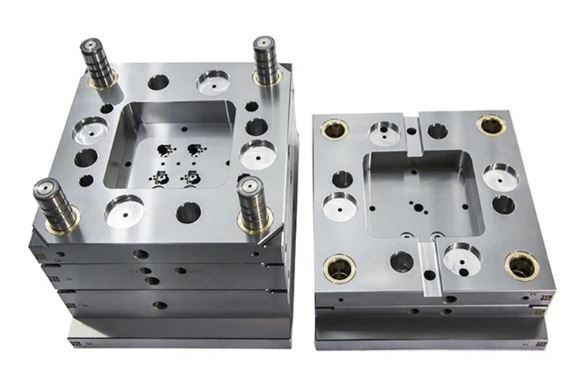
Functional prototype of Aluminum injection mold
These molds are particularly beneficial for iterative design processes. They enable quick and cost-effective production of small batches, allowing designers and engineers to test and refine prototypes with minimal investment. This flexibility is vital for experimenting with design changes, ensuring the final product meets all requirements before mass production.
If you are in a fast-paced industry, aluminum injection mold balances the high-quality output with quick production times. It facilitates a smooth transition from concept to functional prototype, greatly enhancing the development process and paving the way for successful product launches.
Aluminum injection mold would range between $23,000 and $34,000. It’s important to note that these costs can vary based on the complexity of the mold, the precision and specific requirements, and the manufacturing location.
For example, Injection Mold manufacturing services in China are cost-effective yet have no compromise in quality and precision. You can request the quote for injection mold machining to check the precision and budget.
Related: How much does Injection Molding Cost?
Try Prolean Now!
The Cost of Aluminum Injection Mold
The cost of an aluminum injection mold can vary widely based on many factors including complexity, size, and precision requirements.
To provide a realistic breakdown of the costs. Let’s consider a specific example. Imagine we are manufacturing an aluminum mold for a standard smartphone case. This mold would have moderate complexity, including features like thin walls, precise cutouts for buttons and cameras, and a textured surface finish.
Mold Specifications
- Size: Approximately 15cm x 7cm x 1cm.
- Accuracy: ± 0.00125mm
- Complexity: Moderate, with thin walls, precision cutouts, and a textured finish.
- Material: A high-grade aluminum alloy like 7075, known for its strength and durability.
- Production Volume: Designed for a production run of up to 10,000 units.
Table: Aluminum Injection Cost Breakdown
| Cost Component | Description | Estimated Cost |
| Design and Engineering | CAD design, engineering time to finalize mold design | $4,000 – $6,000 |
| Material Cost | Cost of aluminum alloy 7075 | $3,000 – $4,000 |
| CNC Machining | Machining time, labor, machine operation | $10,000 – $15,000 |
| Cooling System and Ejection | Adding a cooling system and ejection mechanism | $2,000 – $3,000 |
| Finishing and Polishing | Surface treatment for texture and smoothness | $1,500 – $2,500 |
| Testing and Adjustments | Initial testing and adjustments for accuracy | $2,500 – $3,500 |
| Total Estimated Cost | Adding all individual costs | $23,000 – $34,000 |
The estimated total cost for this aluminum injection mold would range between $23,000 and $34,000. It’s important to note that these costs can vary based on the complexity of the mold, the precision and specific requirements, and the manufacturing location.
For example, Injection Mold manufacturing services in China are cost-effective yet have no compromise in quality and precision. You can request the quote for injection mold machining to check the precision and budget.
Related: How Much Does Injection Molding Cost? – CNC Machining Service, Rapid prototyping
From Aluminum Mold Machining to Finished Plastic Parts at Prolean
At Prolean, we specialize in transforming concepts into reality through our expert aluminum mold machining services. Our commitment to precision and quality ensures that each mold we create meets the highest standards, serving many industries, from automotive to consumer electronics.
We utilize advanced capabilities of EDM& CNC machining and the strategic combination of both. This technological versatility allows us to tackle complex designs with precision and efficiency, ensuring high-quality molds for any application. Our experienced team leverages these technologies to optimize the mold-making process, ensuring faster turnaround times without compromising on the fine details and accuracy that our clients demand.
In addition to our mold-making capabilities, we also offer comprehensive plastic injection molding services. This means that we don’t just create the molds – we also use them to produce your finished plastic parts. From the initial design phase to delivering the final product at your doorstep, our end-to-end service ensures a seamless, hassle-free experience.
Summing Up
Aluminum injection molds are a significant breakthrough in manufacturing, combining speed, precision, and cost-efficiency. They are invaluable in producing diverse plastic products for various sectors, including household, automotive, and aerospace. The quick heating and cooling capabilities of aluminum drastically reduce production times, making these molds especially suited for rapid prototyping and short-run production. The detailed creation process, enhanced by CNC and EDM technologies, ensures high-quality, precise production.
Their versatility and adaptability in molding different plastics, coupled with faster production and cost reductions, establish aluminum injection molds as a key component in efficient, modern manufacturing, epitomizing innovation and a dedication to quality.
FAQs
What are the advantages of injection molds?
Aluminum molds offer cost-effectiveness, faster cycle times, and excellent thermal conductivity.
How do aluminum molds compare to steel molds?
Aluminum molds are less expensive and have faster cycle times, while steel molds are more durable for high-volume production.
What are the applications of aluminum injection molds?
Industries such as automotive, consumer electronics, and medical devices frequently use aluminum molds.
Can aluminum molds be used for high-volume production?
While ideal for rapid prototyping and low-volume production, they may not be the best choice for very high-volume runs.
How long do aluminum molds last?
With proper maintenance, aluminum molds can last for thousands of cycles, depending on the complexity and application.
What is the cost of an aluminum injection mold?
The cost varies based on size and complexity, but they are generally more cost-effective than steel molds, especially for short runs and prototyping.
Resources
- Sumitomo Electric Industries, Ltd. (2021). E92-13: Aluminum Injection Molding. Retrieved from https://sumitomoelectric.com/sites/default/files/2021-04/download_documents/E92-13.pdf
- Surace, R., & Sorgato, M. (2019). Effect of cavity surface roughness and wettability on the filling flow in micro injection molding. Journal of Manufacturing Processes, 43(Part A), 105-111. Retrieved from https://www.sciencedirect.com/science/article/abs/pii/S1526612518318309

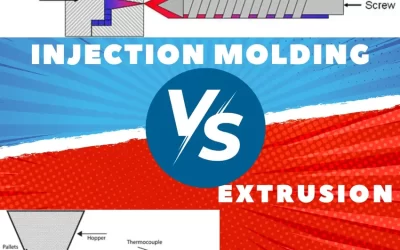

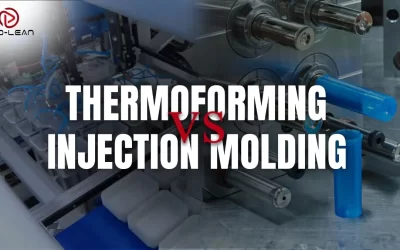
Oh! Does Aluminium molds withstand the high temperature and pressure of the process?
Yes it does meet all the necessary pressure and temperature handling capabilities.